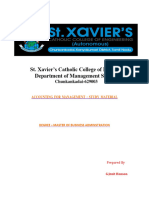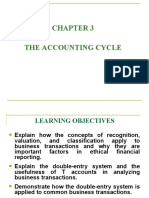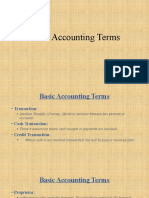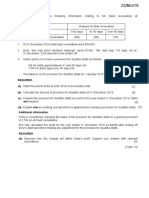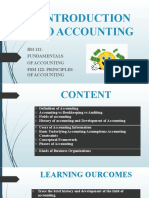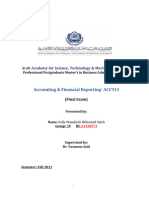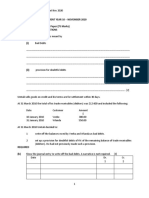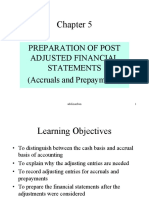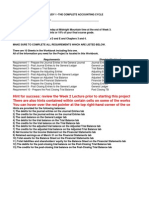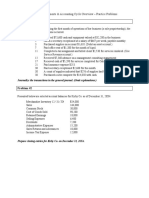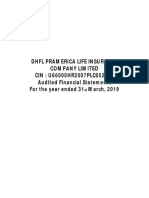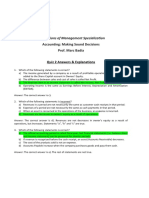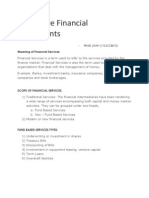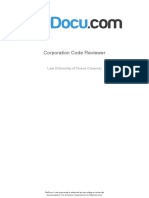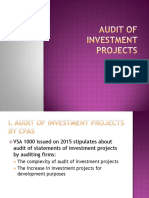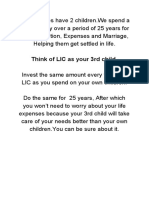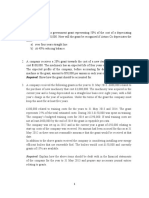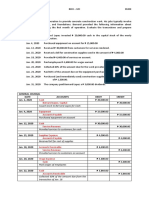Accounting
Notes
Fundamental Ideas and Essential Concepts
��Accounting
Notes
Fundamental Ideas and Essential Concepts
2
�Created by Joshua Corcuera.
Contribution started on May 26, 2019.
For purpose of information and possible future reference for reviews.
What is accounting?
Source Definition
American Accounting Association Process of identifying, measuring,
and communicating economic
information to permit informed
judgment and decisions by users of
the information.
American Institute of Certified Art of recording, classifying, and
Public Accountants summarizing in a significant manner
and in terms of money, transactions,
and events which are in part at
least of financial character, and
interpreting the results thereof.
Accounting Standards Council Service activity that provides
quantitative information, primarily
financial in nature, about economic
entities, that is intended to be useful
in making economic decisions.
Business Transactions
3
�1. Must be expressed monetarily or measurable in money
2. Involves two parties
3. Have a dual effect on the accounting elements
Financial Statements
1. Balance Sheet (Statement of Financial Position)
2. Income Statement
3. Capital Statement (Statement of Changes in Equity)
4. Cash Flow Statement (Statement of Cash Flows)
5. Notes to Financial Statement
Financial statements aim to provide information about the financial
position, financial performance, and cash flows of a business that is useful
to key personalities who are making economic decisions.
Financial statements are the outputs of the accounting process.
Accounting Process
Service Business Merchandising Business
1. Analyze business transactions Analyze business transactions
2. Journalize business transactions Journalize business transactions
4
�3. Post journal entries into ledger Post journal entries into ledger
4. Prepare trial balance Prepare trial balance
5. Journalize and post adjusting Gather adjustments and prepare
entries worksheet
6. Prepare adjusting trial balance Prepare financial statements
7. Prepare financial statements Journalize and post adjusting entries
8. Journalize and post closing Journalize and post closing entries
entries
9. Prepare post-closing trial balance Prepare post-closing trial balance
10. Journalize and post reversing Journalize and post reversing entries
entries
Highlighted in yellow the difference of the accounting process in the two distinct
forms of business (according to activities)
GAAP, Assumptions, and Principles
GAAP - Generally Accepted Accounting Principles
- developed by accounting professionals as a guide for preparing
financial statements
Assumptions
1. Economic Entity Assumption
- business transactions are separate from owner’s personal
transactions unless it involves investment or withdrawal of resources
from the business.
- for instance, the accounting records of the business must not
include the personal assets and liabilities of the owner.
5
�2. Accrual Basis Assumption
- assumes that revenue is recorded when earned regardless when
cash is received and that expense is recorded when incurred
regardless when cash is paid.
3. Going Concern Assumption
- in the absence of contrary information, a business is assumed to
operate indefinitely.
4. Monetary Unit Assumption
- Philippine entities must report economic activities in Philippine Peso.
- more importantly, only transactions expressed in money are to be
recorded.
- disregards any inflation in the economy.
5. Time Period Assumption
- life of an economic entity can be divided into artificial time periods
such as monthly or quarterly.
Principles
1. Cost Principle
- assets acquired should be valued and recorded based on actual
cash equivalent or original cost of acquisition, not the prevailing
market value or future value.
2. Full Disclosure Principle
6
� - accountants should include sufficient information to permit users to
make an informed judgment.
3. Matching Principle
- expenses must be matched with revenues.
4. Revenue Recognition Principle
- revenue is recognized when earned regardless when cash is paid,
expense is recognized when incurred regardless when cash is
received.
5. Materiality Principle
- allows accountant to violate the matching principle if something is
judged as immaterial.
- for example, the purchase of a P300 calculator with an estimated
life of 5 years by a big company can be recorded entirely as an
expense for that year instead of P60 per year. The justification is that it
is not misleading.
6. Conservatism or Prudence Principle
- accountants can anticipate or disclose losses and can be recorded
when they are probable and can be reasonably estimated. The same
action cannot be done on gains.
7. Objectivity Principle
- states that business transactions must be have some form of
impartial supporting evidence or documentation.
- bookkeeping and financial recorded shall be carried out without
bias and prejudice.
7
�Accounting Equation
ASSETS = LIABILITIES + CAPITAL
(owner’s equity)
Left side for debit, right side for credit
Rules of Debit and Credit
Normal Balance Increase Decrease
Assets Debit Debit Credit
Liabilities Credit Credit Debit
Capital Credit Credit Debit
Revenue Credit Credit Debit
Expenses Debit Debit Credit
Normal Balance Increase Decrease
Owner, Capital Credit Credit Debit
Owner, Drawing Debit Debit Credit
Contra-asset or Credit Credit Debit
valuation
account
Contra-revenue Debit Debit Credit
8
�Service Business: Journals and Statements
Journal Entries
Date Particular DR CR
Jan. 1 Cash 300,000
Office Equipment 200,000
Corcuera, Capital 500,000
To record initial investment of the owner
Jan. 2 Furniture and Fixtures 25,000
Accounts Payable 20,000
Cash 5,000
To record purchase of furniture and
fixtures; paid P5,000, balance of P20,000
on account
Jan. 3 Accounts Receivables 50,000
Service Income 50,000
To record services rendered on account
Jan. 4 Cash 15,000
Service Income 15,000
To record cash received from services
rendered
9
�Jan. 5 Notes Receivables 23,000
Service Income 23,000
To record notes received from services
rendered
Jan. 6 Accounts Payable 10,000
Cash 10,000
To record partial payment of account
Jan. 7 Cash 13,000
Accounts Receivables 13,000
To record cash collected
Jan. 8 Office Equipment 80,000
Notes Payable 60,000
Cash 20,000
To record purchase of office equipment;
paid P20,000, issued notes for balance
Jan. 9 Cash 200,000
Loan Payable 200,000
To record loan secured from bank
Jan. 10 Office Supplies 15,000
Accounts Payable 15,000
To record purchase of office supplies, on
account.
Jan. 11 Salaries Expense 25,000
Cash 25,000
10
� To record payment of salaries of workers
Jan. 12 Accounts Payable 2,000
Office Supplies 2,000
To record office supplies returned due to
defects
Jan. 13 Cash 3,000
Notes Receivables 3,000
To record cash collected from notes
Jan. 14 Advertising Expense 18,000
Cash 18,000
To record expenses on advertising
Jan. 15 Accounts Receivables 25,000
Cash 2,000
Service Income 27,000
To record services rendered, P27,000.
Received P2,000, balance on account
Jan. 16 Corcuera, Drawings 28,000
Cash 28,000
To record withdrawal of owner
Jan. 17 Loan Payable 100,000
Cash 100,000
To record partial payment of loan to
bank
Jan. 18 Rent Expenses 35,000
Cash 35,000
To record payment for rent
Jan. 19 Accounts Receivables 9,000
11
� Cash 6,000
Service Income 15,000
To record services rendered, P15,000.
Collected P6,000, balance on account
Jan. 20 Supplies Expense 7,000
Office Supplies 7,000
To record office supplies used
Posting into Ledger through T-accounts
CASH
1/1 300,000 1/2 5,000
1/4 15,000 1/6 10,000
1/7 13,000 1/8 20,000
1/9 200,000 1/11 25,000
1/13 3,000 1/14 18,000
1/15 2,000 1/16 28,000
1/19 6,000 1/17 100,000
1/18 35,000
539,000 241,000
DR 298,000
ACCOUNTS RECEIVABLES
1/3 50,000 1/7 13,000
1/15 25,000
12
�1/19 9,000
84,000 13,000
DR 71,000
NOTES RECEIVABLES
1/5 23,000 1/13 3,000
DR 20,000
OFFICE SUPPLIES
1/10 15,000 1/12 2,000
1/20 7,000
DR 6,000
FURNITURE AND FIXTURES
1/2 25,000
DR 25,000
OFFICE EQUIPMENT
1/1 200,000
1/8 80,000
DR 280,000
ACCOUNTS PAYABLE
13
�1/6 10,000 1/2 20,000
1/12 2,000 1/10 15,000
12,000 35,000
CR 23,000
NOTES PAYABLE
1/8 60,000
CR 60,000
LOAN PAYABLE
1/17 100,000 1/9 200,000
CR 100,000
SERVICE INCOME
1/3 50,000
1/4 15,000
1/5 23,000
1/15 27,000
1/19 15,000
CR 130,000
SALARIES EXPENSE
1/11 25,000
DR 25,000
ADVERTISEMENT EXPENSE
14
�1/14 18,000
DR 18,000
RENT EXPENSE
1/18 35,000
DR 35,000
SUPPLIES EXPENSE
1/20 7,000
DR 7,000
CORCUERA, CAPITAL
1/1 500,000
CR 500,000
CORCUERA, DRAWINGS
1/16 28,000
DR 28,000
Unadjusted Trial Balance
CORCUERA & COMPANY CORPORATION
Trial Balance
January 30, 2019
Account Title Debit Credit
Cash 298,000
15
�Accounts Receivables 71,000
Notes Receivables 20,000
Office Supplies 6,000
Furniture and Fixtures 25,000
Office Equipment 280,000
Accounts Payable 23,000
Notes Payable 60,000
Loan Payable 100,000
Corcuera, Capital 500,000
Corcuera, Drawings 28,000
Service Income 130,000
Salaries Expense 25,000
Advertisement Expense 18,000
Rent Expense 35,000
Supplies Expense 7,000
Totals P 813,000 P 813,000
After this, adjusting entries are journalized and posted to prepare for an adjusted
trial balance. In this case, it will skip those two steps, due to the absence of
adjusting entries, to proceed to the preparation of Financial Statements.
Preparation of Financial Statements
Name of Business (who)
Statement of Comprehensive Income (what)
Period (when)
Service Income P 130,000
Less Operating Expenses:
Salaries Expense P25,000
16
� Advertising Expense 18,000
Rent Expense 35,000
Supplies Expense 7,000 85,000
Net Income P 45,000
Name of Business
Statement of Changes in Owner’s Equity
Period
Beginning Capital P 500,000
Add (deduct):
Withdrawals (P 28,000)
Net Income P 45,000 17,000
End Capital P 517,000
Name of Business
Statement of Financial Position
Period
Assets: Liabilities:
Cash P 298,000 Accounts Payable P 23,000
Accounts Receivables 71,000 Notes Payable 60,000
Furnitures and Fixtures 25,000 Loan Payable 100,000
Office Equipment 280,000 Capital:
Notes Receivables 20,000 Corcuera, Capital 517,000
Office Supplies 6,000
Total Assets P 700,000 Total Liabilities & Capital P 700,000
Statement of Financial Position shown above is in account form. Most businesses
use report form, shown below.
17
� Name of Business
Statement of Financial Position
Period
Assets:
Cash P 298,000
Accounts Receivables 71,000
Furnitures and Fixtures 25,000
Office Equipment 280,000
Notes Receivables 20,000
Office Supplies 6,000
Total Assets P 700,000
Liabilities and Capital:
Accounts Payable P 23,000
Notes Payable 60,000
Loan Payable 100,000
Corcuera, Capital 517,000
Total Liabilities and Capital P 700,000
Manufacturing Business: Formulas, Schedules, and Statements
Formulas
TMC = DM + DL + FO
PC = DM + DL
18
�CC = DL + FO
TMC - Total Manufacturing Cost
PC - Prime Cost
CC - Conversion Cost
DM - Direct Materials
DL - Direct Labor
FO - Factory Overhead
Schedules
Name of Business (who)
Schedule of Cost of Goods Sold (what)
Period (when)
Direct Materials P xxx
Direct Labor xxx
Factory Overhead xxx
Total Manufacturing Cost xxx
Add Work-in-Process, beginning xxx
Total Costs Put Into Process xxx
Less Work-in-Process, ending xxx
Cost of Goods Manufactured xxx
Add Finished Goods, beginning xxx
Total Goods Available for Sale xxx
Less Finished Goods, ending xxx
Cost of Goods Sold P xxx
Name of Business
19
� Schedule of Direct Materials Used
Period
Direct Materials, beginning P xxx
Add Net Purchases:
Direct Materials Purchases xxx
Freight-in xxx xxx
Materials Available for Use xxx
Less Direct Materials, ending xxx
Direct Materials Used P xxx
Name of Business
Schedule of Net Sales
Period
Gross Sales P xxx
Less:
Sales Return and Allowances xxx
Sales Discount xxx xxx
Net Sales P xxx
Income Statement
Name of Business
Statement of Comprehensive Income
Period
Sales P xxx
20
�Less Cost of Goods Sold xxx
Gross Profit xxx
Less Operating Expenses
Administrative Expenses xxx
Selling Expenses xxx xxx
Operating Income xxx
Add (deduct) other income (expenses) xxx
Net Income P xxx
Current Assets
Non-Current Assets
Current Liabilities
Non-Current Liabilities
21


